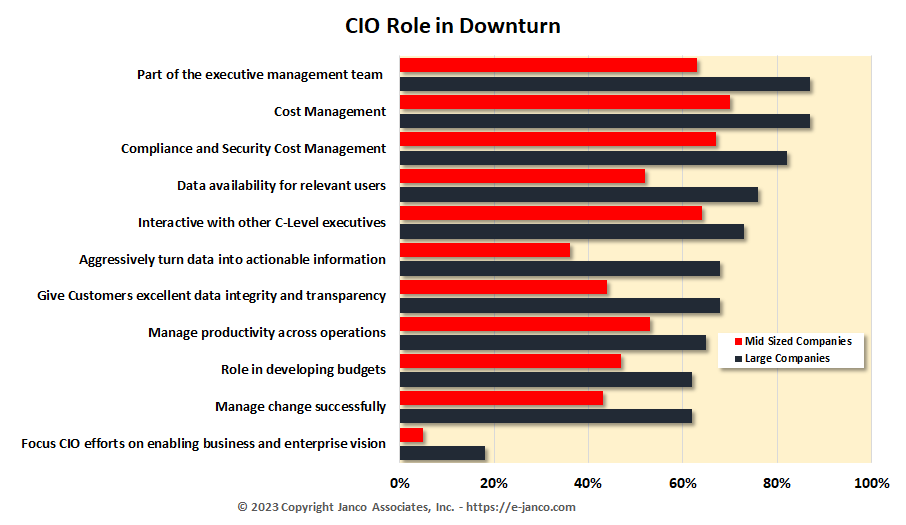CIO Role in a Downturn
Recessions impact every enterprise - best to be prepared
CIOs need to take immediate proactive steps to manage an economic downturn and be able to quickly adjust to the new realities that enterprises face.
The IT Governance Infrastructure Strategy should be updated and include at least the following action steps:
- Update Business IT Plans and Budgets- Assume the worst will happen - Prioritize all IT and enterprise initiatives.
- Put in place a hiring freeze - Proceed to hire only if the position is needed to comply with the updated Business IT plan.
- Evaluate all spending plans for projects and staffing - Will the current situation still support them?
- Evaluate the need to continue existing consulting and contract service contracts - What costs and risks are faced if the contracts are terminated or suspended immediately?
- Convert any "key" contractors to employees - If the role the contractor is playing within the enterprise is critical convert it to an employee position and be ready to explain the increase in head count.
- Suspend any upgrades in software and hardware that are not critical to the enterprise's success - Determine if the ROI is still the same given today's situation.
- Validate Security and Compliance Requirements – This is no time to have “unforced” operational errors. A major breach or failure to meet compliance mandates is something that
- Update Business Continuity & Disaster Plans - business interruptions occur when you least expect them
CIOs challenges in a downturn
The major challenge for CIO is defining the technology affairs of the enterprise while balancing technological and computing services with financial and marketing needs. Seamless integration of data and information from the customer, through product and service design, financial statements, and management reporting is a primary concern.
Technology is extremely important to the enterprise’s current and future business operations. The CIO ensures the continued success of these areas while simultaneously minimizing costs and maximizing equipment and employee performance.
CIOs Role in a downturn
The role of the CIO in a downturn is critical. The job’s focus is overseeing technology as economic conditions change. No longer is the chief information officer the “nerd-in-chief,” merely chasing after viruses and ordering new mouse pads. Now the CIO is finding ways to utilize staff, hardware, and software for strategic business purposes, such as discerning productivity, market opportunities, and improving customer service.
The CIO must look at the enterprise and be able to apply technology as a strategic weapon. The technologies that the CIO must understand and apply are:
- Business Operations Management – Linking business infrastructure with both internal and external systems. This includes both legacy IT as well as customer and supplier-facing Internet solutions
- Security and Compliance – Making security and compliance as core requirements for IT Infrastructure.
- Integration and Mobile Computing – Integrating enterprise information for access and security with multiple disparate sources. Include cloud resource management.
- Social Networking – Implementing a paradigm that changes the focus for reputation, marketing, and operations away from “brick and mortar” and centralized strategic direction to more of a “Brand Management” approach.
- Portfolio Management – Focusing on productivity, ROI, and investment priorities rather than technology advancement to use the “newest” technologies.
- Vendor Management – Automate relationships with integration at the lowest levels including vendor evaluations, supply chain management, contracting, market analysis, contingency planning, payments, and dispute resolutions.
CIO Infrastructure Tool Kit
With the ever-changing economic environment and the explosion of technology into every facet of day-to-day activities there is a need to define an effective infrastructure to support the operating environment; have a strategy for the deployment and technology; and clearly define responsibilities and accountabilities for the use and application of technology. The CIO Infrastructure Tool Kit fills that need.
The CIO Infrastructure Tool Kit versions contain essential tools that your enterprise needs as it creates budgets and sets priorities in all economic conditions. The kit includes the IT Infrastructure, Strategy and Charter Template, the latest IT salary data, the Business Impact and Application Questionnaire, Service Level Policy Template with sample metrics, Functional Specification Template, and the Practical Guide for IT Outsourcing.
Read On Order IT Governance Strategy Download Sample





